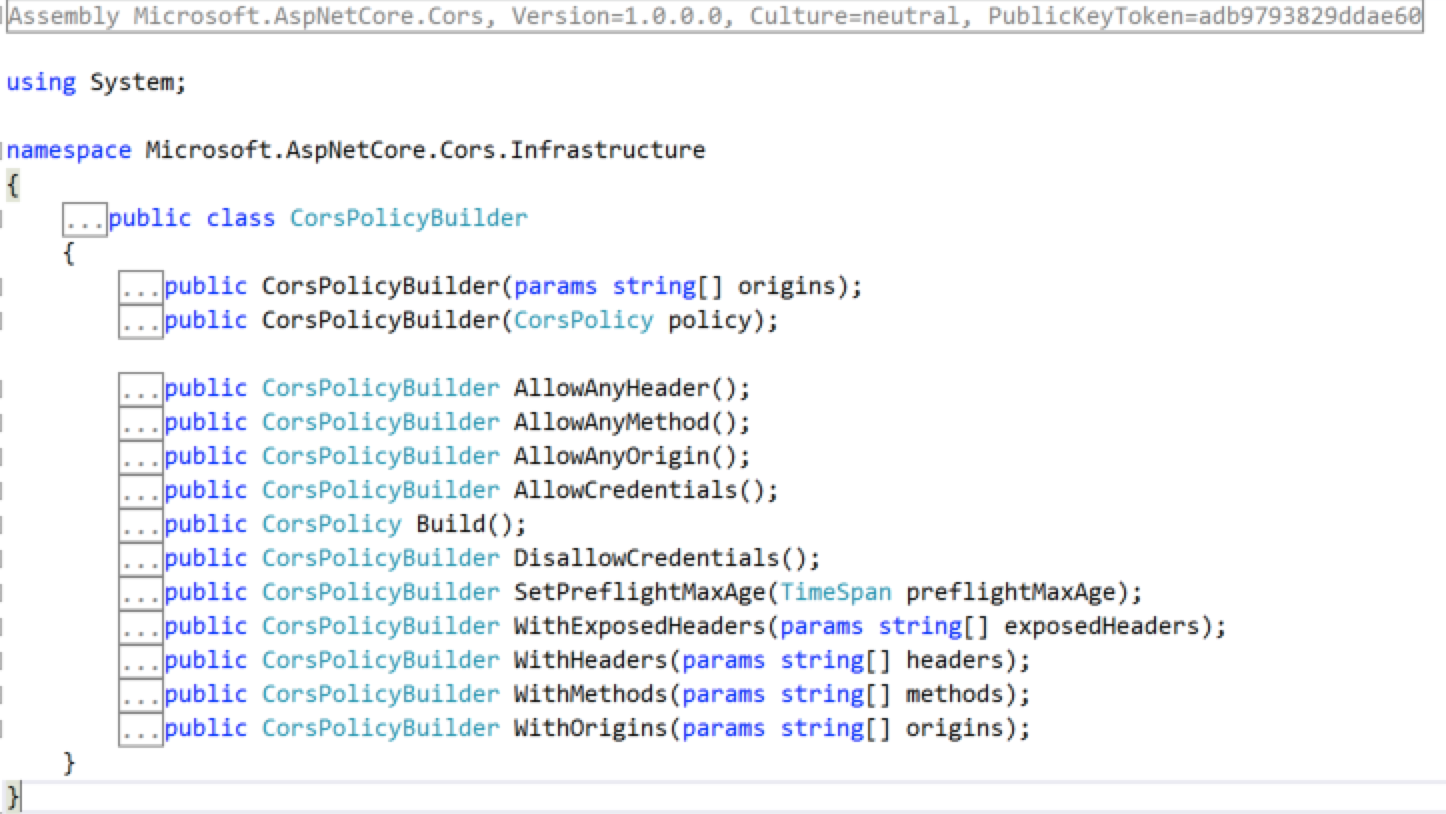ASP.NET Core CORS 简单使用
CORS 全称"跨域资源共享"(Cross-origin resource sharing)。
跨域就是不同域之间进行数据访问,比如 a.sample.com 访问 b.sample.com 中的数据,我们如果不做任何处理的话,就会出现下面的错误:
XMLHttpRequest cannot load b.sample.com. No 'Access-Control-Allow-Origin' header is present on the requested resource. Origin 'a.sample.com' is therefore not allowed access. The response had HTTP status code 404.
请求和响应信息:
Response Headers
Content-Type:text/html; charset=utf-8
Server:Microsoft-IIS/10.0
X-Powered-By:ASP.NET
Request Headers
Accept:*/*
Accept-Encoding:gzip, deflate
Accept-Language:zh-CN,zh;q=0.8
Connection:keep-alive
Content-Length:32384
Host:b.sample.com
Origin:a.sample.com
当请求发起后,Host 会获取 Origin,然后进行判断是否同意这个请求,判断的标准就是 Access-Control-Allow-Origin,如果 Host 服务器指定了 Origin 的配置,那么在响应头就会有:
Access-Control-Allow-Origin:a.sample.com
相关的 Access-Control-*:
- Access-Control-Allow-Origin:指定请求头中 Origin 是否被访问,如果值为 *,则表示可以让任何 Origin 访问。
- Access-Control-Request-Method:允许的 HTTP 请求方法,常用 Get、Post、Put 等,如果值为 *,则表示允许所有的 HTTP 请求方法访问。
- Access-Control-Expose-Headers:客户端默认可以从服务器获取响应头中的 Cache-Control、Content-Language、Content-Type、Expires、Last-Modified、Pragma 字段信息,如果需要额外获取其它 header 字段信息,则需要在服务端进行配置。
Access-Control-Request-Headers:允许客户端向服务器发送的额外请求头信息,和上面的 Access-Control-Expose-Headers 比较相似,但方向是相反的,一般会用在添加自定义 header 的时候,比如 X-Param 等等。 - Access-Control-Allow-Credentials:如果值为 true,则表示服务端可以接受客户端发送的 Cookie 信息,但客户端请求中需要同时设置
withCredentials = true;。 - Access-Control-Max-Age:请求检查的缓存时间,即在一段时间内,客户端向服务器发送请求,不需要再进行检查 Origin 的配置,而是直接进行请求访问,当然服务器更改配置后除外。
以上是 CORS 的基本相关信息,我们在 ASP.NET MVC 应用程序开发中,需要手动配置 CORS:
public class AllowCorsAttribute : ActionFilterAttribute
{
private string[] _domains;
public AllowCorsAttribute(params string[] domains)
{
_domains = domains;
}
public override void OnActionExecuting(ActionExecutingContext filterContext)
{
var context = filterContext.RequestContext.HttpContext;
if (context.Request.UrlReferrer != null)
{
var host = context.Request.UrlReferrer?.Host;
if (host != null && _domains.Contains(host))
{
context.Response.AddHeader("Access-Control-Allow-Origin", $"http://{host}");
}
}
else
{
context.Response.AddHeader("Access-Control-Allow-Origin", "*");
}
context.Response.AddHeader("Access-Control-Allow-Methods", "GET, HEAD, OPTIONS, POST, PUT");
context.Response.AddHeader("Access-Control-Allow-Headers", "Access-Control-Allow-Headers, Origin,Accept, X-Requested-With, Content-Type, Access-Control-Request-Method, Access-Control-Request-Headers");
base.OnActionExecuting(filterContext);
}
}
上面代码就是截获每次 Action 请求,手动向请求上下文中增加相应头的配置,以达到 CORS 的目的,Action 配置:
[AllowCors("a.sample.com", "c.sample.com")]
public ActionResult Index()
{
return View();
}
而在 ASP.NET WebAPI 项目中配置 CORS,就不需要上面那么复杂了,我们只需要安装:
Install-Package Microsoft.AspNet.WebApi.Cors
然后配置启用 CORS:
public static class WebApiConfig
{
public static void Register(HttpConfiguration config)
{
config.EnableCors();
config.Routes.MapHttpRoute(
name: "DefaultApi",
routeTemplate: "api/{controller}/{id}",
defaults: new { id = RouteParameter.Optional }
);
}
}
最后在对应的 Action 上面添加 CORS 配置就行了:
[EnableCors(origins: "http://a.sample.com", headers: "*", methods: "get,post", SupportsCredentials = true)]
public ActionResult Index()
{
return View();
}
在 ASP.NET Core 的 CORS 配置和上面差不多,配置方法:

ConfigureServices 中添加配置:
public void ConfigureServices(IServiceCollection services)
{
// Add framework services.
services.AddMvc();
services.AddCors(options => options.AddPolicy("CorsSample",
p => p.WithOrigins("http://a.example.com", "http://c.example.com").AllowAnyMethod().AllowAnyHeader()));
}
Configure 中启用配置:
public void Configure(IApplicationBuilder app, IHostingEnvironment env, ILoggerFactory loggerFactory)
{
app.UseStaticFiles();
app.UseMvc(routes =>
{
routes.MapRoute(
name: "default",
template: "{controller=Home}/{action=Index}/{id?}");
});
app.UseCors("CorsSample");
}
Action 启用对应的 CORS,不启用使用[DisableCors]。
[EnableCors("CorsSample")]
public ActionResult Index()
{
return View();
}
当然 CORS 在 ASP.NET Core 的使用不仅于此,你也可以进行自定义,具体查看最后的参考资料。
跨域除了 CORS,还有其它的解决方式:
- JSONP:通过在文档中嵌入一个
<script>标记来从另一个域中返回数据,所以只支持 GET 请求,但使用比较简单,资料:ASP.NET Web API 配置 JSONP - document.domain:JS 配置代码
document.domain = ‘sample.com’;,设置完之后,同域之间就可以 JS 互相访问了,但存在一些隐患,比如一个站点被 JS 注入了,那么就会牵扯到其它站点,资料:ASP.NET 页面禁止被 iframe 框架引用
参考资料:
微信公众号:你好架构
出处:http://www.cnblogs.com/xishuai/
公众号会不定时的分享有关架构的方方面面,包含并不局限于:Microservices(微服务)、Service Mesh(服务网格)、DDD/TDD、Spring Cloud、Dubbo、Service Fabric、Linkerd、Envoy、Istio、Conduit、Kubernetes、Docker、MacOS/Linux、Java、.NET Core/ASP.NET Core、Redis、RabbitMQ、MongoDB、GitLab、CI/CD(持续集成/持续部署)、DevOps等等。
本文版权归作者和博客园共有,欢迎转载,但未经作者同意必须保留此段声明,且在文章页面明显位置给出原文连接。






【推荐】国内首个AI IDE,深度理解中文开发场景,立即下载体验Trae
【推荐】编程新体验,更懂你的AI,立即体验豆包MarsCode编程助手
【推荐】抖音旗下AI助手豆包,你的智能百科全书,全免费不限次数
【推荐】轻量又高性能的 SSH 工具 IShell:AI 加持,快人一步
· 10年+ .NET Coder 心语,封装的思维:从隐藏、稳定开始理解其本质意义
· .NET Core 中如何实现缓存的预热?
· 从 HTTP 原因短语缺失研究 HTTP/2 和 HTTP/3 的设计差异
· AI与.NET技术实操系列:向量存储与相似性搜索在 .NET 中的实现
· 基于Microsoft.Extensions.AI核心库实现RAG应用
· 10年+ .NET Coder 心语 ── 封装的思维:从隐藏、稳定开始理解其本质意义
· 地球OL攻略 —— 某应届生求职总结
· 提示词工程——AI应用必不可少的技术
· Open-Sora 2.0 重磅开源!
· 周边上新:园子的第一款马克杯温暖上架